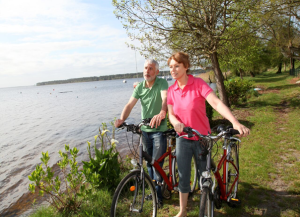Exercise is a powerful means of recovering physically, mentally, and emotionally.
Exercising as part of a rehabilitation program may include ways to improve your overall physical conditioning, such as general cardiovascular or strengthening programs, or may include specific exercises designed to combat specific impairments created by cancer treatment.
Overall, physical activity is a key component of cancer rehabilitation, yet only about 30% of cancer patients report meeting national exercise guidelines (1). Exercising and being physically active has been shown to (2):
- Decrease cancer-related fatigue
- Improve quality of life

- Prevent or reduce swelling (lymphedema)
- Reduce the risk of recurrence of certain cancers
- Maintain a healthy body weight
- Decrease the burden of cancer treatments such as chemotherapy and radiation
Individualized exercise programs may contain such elements as:
- Strengthening exercises to prevent or treat deconditioning from long periods of immobility
- Stretching exercises for tight muscles after surgery and radiation
- Massage for tight tissues such as a scar after surgery
- Decongestive exercises for lymphedema
- Cardiovascular exercise to improve overall health and combat fatigue
Resources for exercise as part of a cancer rehabilitation program
- Prevent and reduce stiffness caused by radiation treatment
- Life After Cancer Treatment (Canadian Cancer Society)
- Swallowing Exercises
Available online, in booklet format, or can be borrowed from the Princess Margaret Patient and Family Library
Find help with exercise for cancer rehabilitation
- Wellspring Cancer Exercise program
A free 30 week individualized program offered at most Wellspring locations – downtown Toronto, Sunnybrook (Westerkirk house), Oakville, Brampton, London, Niagara. Information specific to each location can be found on the individual location’s Wellspring page. - CancerSmart Exercise
Led by individuals with specialized training in cancer rehabilitation and offered at the following locations for a fee:- Body + Soul Fitness, Toronto
- Cancer Rehabilitation and Survivorship program
A team of physiotherapists, occupational therapists, kinesiologists and massage therapist are available for one-on-one assessments and recommendations around exercise, fatigue, pain, or other concerns. University Health Network patients only. - Find a Program or Therapist
There are also many options such as yoga, tai chi, or qi gong offered at various community organizations.
(1) Hefferon, K., Murphy, H., McLeod, J., Mutrie, N., & Campbell, A. (2013). Understanding barriers to exercise implementation 5-year post-breast cancer diagnosis: A large-scale qualitative study. Health Education Research, 28(5), 843.
(2) Schmitz, K. H., Courneya, K. S., Matthews, C., Demark-Wahnefried, W., Galvão, D. A., Pinto, B. M., . . . American College of Sports Medicine. (2010). American college of sports medicine roundtable on exercise guidelines for cancer survivors. Medicine and Science in Sports and Exercise, 42(7), 1409-1426. doi:10.1249/MSS.0b013e3181e0c112